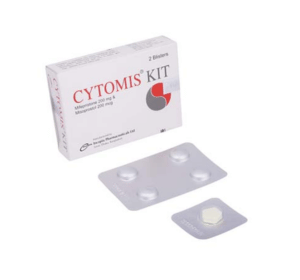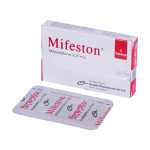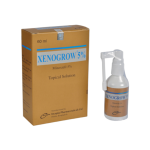CYTOMIS KIT(Mifepristone & Misoprostol)

Therapeutic Group: Gynaecological
Presentation
Each box contains 2 blister strips.
Mifeston strip: 1 strip contains 1 tablet of Mifepristone INN 200 mg.
Cytomis 200 Buccal Strip: 1 strip contains 4 tablet of Misoprostol BP 200 microgram.
Description
Mifepristone is an antiprogestin; that is, it blocks the action of progesterone, a naturally produced hormone that prepares the inner lining of the uterus for implantation of a fertilized ovum and support of a growing embryo and placenta. The drug is taken orally in a prescribed dose during the first seven to nine weeks of pregnancy, and within two days the uterine lining begins to deteriorate, usually causing bleeding similar to that experienced during normal menstruation. The Mifepristone is then followed up by a dose (taken orally or as a vaginal suppository) of the synthetic prostaglandin, which stimulates the uterus to undergo contractions. The embryo and other uterine contents are expelled in a process very similar to spontaneous abortion or miscarriage.
Misoprostol is a synthetic prostaglandin E1 analogue that has uterine contractibility properties. Misoprostol interact with specific receptors on myometrial cells causes myometrial contraction thus soften & open the cervix resulting in the expulsion of uterine contents.
Indications
Cytomis Kit is indicated for early Menstrual Regulation (MR) up to 9 weeks (63 days) of gestation; i.e. for medical termination of pregnancy.
Dosage & Administration
Cytomis Kit can only be prescribed by qualified medical professionals who are able to assess the gestational age of an embryo and to diagnose ectopic pregnancies.
Day 1 (First visit): Mifepristone administration
One tablet of Mifepristone (200 mg) is taken in a single oral dose under the supervision of a qualified medical professional in a clinic, medical office or hospital.
Day 2 (second visit): Misoprostol administration
24-48 hours after ingesting of Mifepristone tablet, the patient takes 4 tablets of 200 microgram (800 micrograms) of Misoprostol buccally. Misoprostol tablets can be administered by the patient herself (place two tablets on each side of cheek & gum). She should wait for 30 minutes.
During the period immediately following the administration of Misoprostol, the patients may need medication for cramps or gestational symptoms. The patient should be given a phone number to call if she has questions following the administration of Misoprostol.
Day 10 to 14
Patients must return to the clinic, medical office or hospital within 10 to 14 days after the administration of Mifepristone. This visit is very important to confirm by clinical examination or ultrasonographic scan that a complete termination of pregnancy has occurred.
Patients who have an ongoing pregnancy at this visit have a risk of fetal malformation resulting from the treatment. Surgical termination/MVA (Manual vaccum Aspiration) is recommended to manage Menstrual Regulation (MR)/termination of pregnancy failures.
Side Effects
Mifepristone: The treatment is designed to induce the vaginal bleeding and uterine cramping necessary for menstrual Regulation (MR). Commonly reported side effects were nausea, vomiting and diarrhea, pelvic pain, fainting, headache, dizziness and asthenia occurred rarely.
Misoprostol: Gastro-intestinal side effects like diarrhea, abdominal pain, nausea, flatulence, dyspepsia, headache, vomiting and constipation, shivering, hyperthermia, dizziness, pain due to uterine contractions, severe vaginal bleeding, shock, pelvic pain, uterine rupture (requiring surgical repair, hysterectomy and/or salpingo-oophorectomy).
Precautions
Mifepristone & Misoprostol combination should not give to anyone else. Administration must be under the supervision of a qualified physician. The combination of Mifepristone & Misoprostol has been prescribed for the patients specific condition, it may not be the correct treatment for another patients, and may be dangerous to the other women if she is or were to become pregnant. Any intrauterine device (IUD) should be removed before treatment with Mifepristone begins. Menstrual Regulation (MR) by surgery is recommended in cases when combination of Mifepristone & Misoprostol fails to cause Menstrual Regulation. Patients who have an ongoing pregnancy at last visit have a risk of fetal malformation resulting from the treatment. Surgical termination/MVA (Manual vaccum Aspiration) is recommended to manage Menstrual Regulation (MR)/termination of pregnancy failures.
Use in Pregnancy & Lactation
Pregnancy
Mifepristone is indicated for use in the termination of pregnancy (through 63 days pregnancy) and has no other approved indication for use during pregnancy.
Lactation
Mifepristone: It is not known whether Mifepristone is excreted in human milk. Many hormones with a similar chemical structure, however, are excreted in breast milk. Since the effects of Mifepristone on infants are unknown, breast-feeding women should consult with their health care provider to decide if they should discard their breast milk for a few days following administration of the medications.
Misoprostol: Although it is not known whether Misoprostol or Misoprostol acid is excreted in human milk, Misoprostol should not be administered to nursing mothers because the potential excretion of Misoprostol acid could cause diarrhoea in nursing infants.
Use in children
Safety and effectiveness in pediatric patients have not been established.
Drug Interaction
Mifepristone: No interaction studies have been performed. On the basis of this drug’s metabolism by CYP3A4, it is possible that ketoconazole, itraconazole, erythromycin and grapefruit juice may inhibit its metabolism (increasing serum levels of mifepristone). Furthermore, rifampicin, dexamethasone, St John’s Wort and certain anticonvulsants (phenytoin, phenobarbital, carbamazepine) may induce mifepristone metabolism (lowering serum levels of Mifepristone).
Based on invitro inhibition information, co-administration of Mifepristone may lead to an increase in serum levels of drugs that are CYP3A4 substrates.
Limited evidence suggests that co-administration of NSAIDs on the day of prostaglandin administration does not adversely influence the effects of Mifepristone or the prostaglandin on cervical ripening or uterine contractility and does not reduce the clinical efficacy of medical termination of pregnancy.
Misoprostol: Misoprostol has not been shown to interfere with the beneficial effects of aspirin on signs and symptoms of rheumatoid arthritis. Misoprostol does not exert clinically significant effects on the absorption, blood levels and anti-platelet effects of therapeutic doses of aspirin.
Over Dose
Mifepristone: No serious adverse reactions were reported in tolerance studies in healthy nonpregnant female and healthy male subjects where Mifepristone was administered in single doses greater than threefold of 600mg for termination of pregnancy. If a patient ingests a massive overdose, she should be observed closely for signs of adrenal failure.
Misoprostol: Clinical signs that may indicate an overdose are sedation, tremor, convulsions, dyspnea, abdominal pain, diarrhoea, fever, palpitations, hypotension, or bradycardia. Symptomsshould be treated with supportive therapy. It is not known if misoprostol acid is dialyzable.However, because misoprostol is metabolized like a fatty acid, it is unlikely that dialysis would be appropriate treatment for overdosage.
Storage
Store in a cool and dry place, protected from light.
Commercial Pack
Cytomis Kit: Each box contains 1 Alu-PVC blister strip of 1 Mifeston tablet & 1 Alu-Alu blister strip of 4 Cytomis 200 Buccal tablets.



